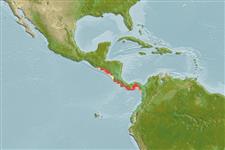Teleostei (teleosts) >
Clupeiformes (Herrings) >
Engraulidae (Anchovies) > Engraulinae
Etymology: Lycengraulis: Greek, lykos = wolf + Greek, eggraulis, -eos = anchovy (Ref. 45335).
Eponymy: Professor Felipe Poey y Aloy (1799–1891) was a Cuban zoologist, naturalist and artist. [...] (Ref. 128868), visit book page.
More on author: Kner.
Environment: milieu / climate zone / depth range / distribution range
Ecology
Marine; brackish; pelagic-neritic; depth range 0 - 50 m (Ref. 189). Tropical; 14°N - 6°N, 91°W - 77°W (Ref. 189)
Eastern Central Pacific: El Salvador to Panama Bay and possibly northern Ecuador.
Size / Weight / Age
Maturity: Lm ? range ? - ? cm
Max length : 20.5 cm SL male/unsexed; (Ref. 189)
Dorsal spines (total): 0; Anal spines: 0; Anal soft rays: 21 - 24. Snout about 2/3 eye diameter; maxilla moderate, tip somewhat bluntly rounded, reaching almost to sub-operculum, teeth becoming larger after first third of jaw. Lower gill rakers fairly short, none rudimentary. Dorsal fin origin behind midpoint of body; anal fin origin under anterior third of dorsal fin base. Silver stripe lost in larger fishes; a curve of black dots on operculum .
Occurs inshore but entering brackish if not fresh water (thus probably similar to L. grossidens). Feeds on fishes (including other anchovies), perhaps also crustaceans. Nearly ripe females occurred in the Gulf of Nicoya, Costa Rica in June, August and September, and juveniles of 3.3-4.5 cm in January and October. TL = 1.257 SL.
Life cycle and mating behavior
Maturity | Reproduction | Spawning | Eggs | Fecundity | Larvae
Nearly ripe females occurred in the Gulf of Nicoya, Costa Rica in June, August and September, and juveniles of 3.3 to 4.5 cm in January and October.
Whitehead, P.J.P., G.J. Nelson and T. Wongratana, 1988. FAO Species Catalogue. Vol. 7. Clupeoid fishes of the world (Suborder Clupeoidei). An annotated and illustrated catalogue of the herrings, sardines, pilchards, sprats, shads, anchovies and wolf-herrings. FAO Fish. Synop. 125(7/2):305-579. Rome: FAO. (Ref. 189)
IUCN Red List Status (Ref. 130435: Version 2024-2)
Threat to humans
Harmless
Human uses
Fisheries: subsistence fisheries
Tools
Special reports
Download XML
Internet sources
Estimates based on models
Preferred temperature (Ref.
123201): 24.4 - 28.6, mean 27.8 °C (based on 16 cells).
Phylogenetic diversity index (Ref.
82804): PD
50 = 0.5312 [Uniqueness, from 0.5 = low to 2.0 = high].
Bayesian length-weight: a=0.00525 (0.00250 - 0.01100), b=3.13 (2.95 - 3.31), in cm total length, based on LWR estimates for this (Sub)family-body shape (Ref.
93245).
Trophic level (Ref.
69278): 4.2 ±0.73 se; based on food items.
Resilience (Ref.
120179): High, minimum population doubling time less than 15 months (Preliminary K or Fecundity.).
Fishing Vulnerability (Ref.
59153): Low vulnerability (15 of 100).
